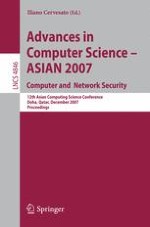2007 | Buch
Advances in Computer Science – ASIAN 2007. Computer and Network Security
12th Asian Computing Science Conference, Doha, Qatar, December 9-11, 2007. Proceedings
herausgegeben von: Iliano Cervesato
Verlag: Springer Berlin Heidelberg
Buchreihe : Lecture Notes in Computer Science
